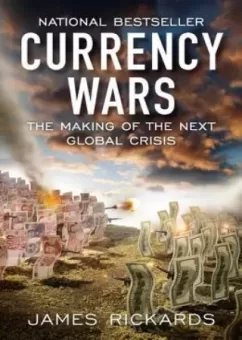Chapter 9
171 In the classic formulation of nineteenth-century economic writer Walter Bagehot . . . All references to Bagehot’s principles for central banking are from Walter Bagehot, Lombard Street: A Description of the Money Market, New York: Scribner, Armstrong, 1873.
174 “We conclude this crisis was avoidable . . .” The Financial Crisis Inquiry Report: Final Report of the National Commission on the Causes of the Financial and Economic Crisis in the United States, New York: Public Affairs, 2011, xvii
175 In 2009, Janet Yellen, then president of the Federal Reserve Bank of San Francisco . . . “Fed Seeks Power to Issue Own Debt When Crisis Ebbs, Yellen Says,” Bloomberg, March 26, 2009.
181 Svensson’s paper is the Rosetta stone of the currency wars . . . Lars E. O. Svensson, “Escaping a Liquidity Trap and Deflation: The Foolproof Way and Others,” Working Paper No. 10195, National Bureau of Economic Research, December 2003
182 “Even if the . . . interest rate is zero . . .” Svensson, op.
182 “If the central bank could manipulate private-sector beliefs . . .” Svensson, op. cit.
185 In a famous study written just before the start of President Obama’s administration . . . Christina D. Romer and Jared Bernstein, “The Job Impact of the American Recovery and Reinvestment Plan,” report prepared by the Council of Economic Advisers, January 9, 2009.
185 One month after the Romer and Bernstein study . . . John F. Cogan, Tobias Cwik, John B. Taylor and Volker Wieland, “New Keynesian Versus Old Keynesian Government Spending Multipliers,” Working Paper No. 14782, National Bureau of Economic Research, February 2009, volkerwielandcom/docs/CCTW%20Mar%202.pdf
186 Empirical support for Keynesian multipliers of less than one, in certain conditions, was reported in separate studies . . . See Charles Freedman, Michael Kumhof, Douglas Laxton, Dirk Muir and Susanna Mursula, “Global Effects of Fiscal Stimulus during the Crisis,” International Monetary Fund, February 25, 2010; Robert J. Barro and Charles J. Redlick, “Macroeconomic Effects from Government Purchases and Taxes,” Working Paper No. 10-22, Mercatus Center, George Mason University, July 2010; and Michael Woodford, “Simple Analytics of the Government Expenditure Multiplier,” paper presented at the meetings of the Allied Social Sciences Association, January 3, 2010.
187 Christ was saying that the impact of Keynesian stimulus . . . Carl F. Christ, “A Short-Run Aggregate-Demand Model of the Interdependence and Effects of Monetary and Fiscal Policies with Keynesian and Classical Interest Elasticities,” The American Economic Review 57, no. 2, May 1967
192 The role of VaR in causing the Panic of 2008 is immense . . . The House of Representatives held one hearing on this topic, at which sworn testimony was provided by Black Swan author Nassim Nicholas Taleb, bank analyst Christopher Whalen and myself, among others. This hearing was held by the Subcommittee on Investigations and Oversight of the Committee on Science, Space and Technology on September 10, 2009. The ostensible reason for using the Science Committee was that VaR is a quantitative and therefore scientific discipline; however, I was informed that this was actually done at the request of Financial Services Committee chairman Barney Frank in order to establish a record on VaR while avoiding the lobbyists who typically influence witness selection and questions in the Financial Services Committee. The consensus of the witnesses was that VaR is deeply flawed and contributed significantly to the financial crisis of 2007–2008. However, this hearing had little impact on the final form of the resulting Dodd-Frank legislation, as no limitations on the use of VaR were imposed. The record is available at http://gop.science.house.gov/Hearings/Detail.aspx?ID=166.
Pages: 1 2 3 4 5 6 7 8 9 10 11 12 13 14 15 16 17 18 19 20 21 22 23 24 25 26 27 28 29 30 31 32 33 34 35 36 37 38 39 40 41 42 43 44 45 46




